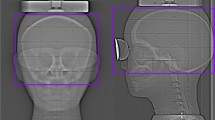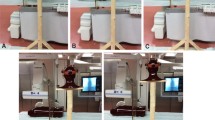Abstract
The objective of this work was to evaluate the dosimetry of tungsten eye shields for use with kilovoltage X-ray beam treatments. The eye shields, originally designed for megavoltage electron beams, were made of 2 mm tungsten thickness and inside diameters of 11.6 and 15.0 mm with optional aluminium caps of 0.5 and 1 mm thickness. The relative dosimetry of the eye shields were examined by measurement of transmission doses with full scatter conditions, central axis depth doses and beam profiles underneath the eye shield. The X-ray beams used in this study ranged in energy from 50 to 280 kVp. Transmission measurements were performed using an Advanced Markus ionisation chamber located at the surface of an RMI457 Solid Water phantom with a 3 cm diameter applicator flush against the phantom surface. Depth doses and profiles measurements were performed in a PTW MP3 scanning water tank with a PTW diamond detector. Results for transmission doses for the medium size eye shield increased from 1 to 22 % for 50–280 kVp while for the smaller eye shield the percentage dose increased from 3.5 to 30 % for the same energy range. There were minimal differences between using the 0.5 and 1 mm aluminium caps. Central axis depth doses measured with and without the eye shields demonstrated the 125 and 180 kVp beams had higher peak doses behind the eye shields. These results show that these tungsten eye shields are suitable for use with kilovoltage X-ray beams. However, the clinical impact needs to be considered for the higher X-ray beam energies.



Similar content being viewed by others
References
Poen JC (1999) Clinical applications of orthovoltage radiotherapy: tumours of the skin, endorectal therapy and intraoperative radiation therapy. Medical Physics Publishing, Madison
Gordon KB, Char DH, Sagerman RH (1995) Late effects of radiation on the eye and ocular adnexa. Int J Radiat Oncol Biol Phys 31:1123–1139
ICRP, Report No. ICRP Publication 103, 2007
Caccialanza M, Piccinno R, Percivalle S, Rozza M (2009) Radiotherapy of carcinomas of the skin overlying the cartilage of the nose: our experience in 671 lesions. J Eur Acad Dermatol Venereol 23:1044–1049
Locke J, Karimpour S, Young G, Lockett MA, Perez CA (2001) Radiotherapy for epithelial skin cancer. Int J Radiat Oncol Biol Phys 51:748–755
Amdur RJ, Kalbaugh KJ, Ewald LM, Parsons JT, Mendenhall WM, Bova FJ, Million RR (1992) Radiation therapy for skin cancer near the eye: kilovoltage X-rays versus electrons. Int J Radiat Oncol Biol Phys 23:769–779
Lye JE, Butler DJ, Webb DV (2010) Enhanced epidermal dose caused by localized electron contamination from lead cutouts used in kilovoltage radiotherapy. Med Phys 37:3935–3939
Williams JR, Thwaites DI (2000) Radiotherapy physics in practice. Oxford University Press, Oxford
Baker CR, Luhana F, Thomas SJ (2002) Absorbed dose behind eye shields during kilovoltage photon radiotherapy. Br J Radiol 75:685–688
Butson MJ, Cheung T, Yu PK, Price S, Bailey M (2008) Measurement of radiotherapy superficial X-ray dose under eye shields with radiochromic film. Phys Med 24:29–33
Grosswendt B (1990) Dependence of the photon backscatter factor for water on source-to-phantom distance and irradiation field size. Phys Med Biol 35:1233–1245
Ma CM, Coffey CW, DeWerd LA, Liu C, Nath R, Seltzer SM, Seuntjens JP (2001) AAPM protocol for 40–300 kV X-ray beam dosimetry in radiotherapy and radiobiology. Med Phys 28:868–893
Butson MJ, Cheung T, Yu PKN (2007) Radiochromic film for verification of superficial X-ray backscatter factors. Australas Phys Eng Sci Med 30:269–273
Nelson VK, Hill RF (2011) Backscatter factor measurements for kilovoltage X-ray beams using thermoluminescent dosimeters (TLDs). Radiat Meas 46:2097–2099
Kim J, Hill R, Claridge Mackonis E, Kuncic Z (2010) An investigation of backscatter factors for kilovoltage X-rays: a comparison between monte carlo simulations and gafchromic EBT film measurements. Phys Med Biol 55:783–797
Butson MJ, Cheung T, Yu PKN (2008) Measurement of dose reductions for superficial X-rays backscattered from bone interfaces. Phys Med Biol 53:N329–N336
Klevenhagen SC (1982) The build-up of backscatter in the energy range 1–8 mm Al HVT (radiotherapy beams). Phys Med Biol 27:1035–1043
Healy BJ, Gibbs A, Murry RL, Prunster JE, Nitschke KN (2005) Output factor measurements for a kilovoltage X-ray therapy unit. Australas Phys Eng Sci Med 28:115–121
Hill R, Kuncic Z, Baldock C (2010) The water equivalence of solid phantoms for low energy photon beams. Med Phys 37:4355–4363
Hill R, Holloway L, Baldock C (2005) A dosimetric evaluation of water equivalent phantoms for kilovoltage X-ray beams. Phys Med Biol 50:N331–N344
Hill R, Mo Z, Haque M, Baldock C (2009) An evaluation of ionization chambers for the relative dosimetry of kilovoltage X-ray beams. Med Phys 36:3971–3981
Knoos T, Rosenschold PMA, Wieslander E (2007) Modelling of an Orthovoltage X-ray Therapy Unit with the EGSnrc Monte Carlo Package. J Phys Conf Ser 74:021009
Munck P, Rosenschold AF, Nilsson V, Knoos T (2008) Kilovoltage X-ray dosimetry–an experimental comparison between different dosimetry protocols. Phys Med Biol 53:4431–4442
Lee CHM, Chan KKD (2000) Electron contamination from the lead cutout used in kilovoltage radiotherapy. Phys Med Biol 45(1):1–8
Ma L, Ma CM, Nacey JF, Boyer AL (1999) Determination of cone effects on backscatter factors and electron contamination for superficial X-rays. In: Ma CM, Seuntjens JP (eds) Kilovoltage X-ray beam dosimetry for radiotherapy and radiobiology. Medical Physics Publishing, Madison, pp 279–290
Klevenhagen SC, D’Souza D, Bonnefoux I (1991) Complications in low energy X-ray dosimetry caused by electron contamination. Phys Med Biol 36:1111–1116
Author information
Authors and Affiliations
Corresponding author
Rights and permissions
About this article
Cite this article
Wang, D., Sobolewski, M. & Hill, R. The dosimetry of eye shields for kilovoltage X-ray beams. Australas Phys Eng Sci Med 35, 491–495 (2012). https://doi.org/10.1007/s13246-012-0166-9
Received:
Accepted:
Published:
Issue Date:
DOI: https://doi.org/10.1007/s13246-012-0166-9




